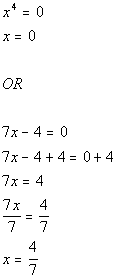If the polynomial equation is factorable, the roots are determined by solving each factor when it is equal to zero. For example,

The x-intercepts of the graph are 0 and 4/7. The x-intercepts of a polynomial function graph correspond to the real roots of the polynomial equation P(x) = 0. Therefore, the roots for the polynomial equation in the example above is also 0 and 4/7.
P(x) can also be solved using the factor theorem. To solve the cubic x3 - x2 + x -1 = 0,
we first figure out the values that should be tested using the rational zero theorem. If P(x) is a polynomial function with integer coefficients and x = b/a is a zero of P(x), then b is a factor of the constant term while a is a factor of the leading coefficient. Furthermore, ax - b is a factor of P(x). Back to the equation, since a=1 and b=-1, the only possible values of b/a is
 1. By substitution, we see that x=1 is a root thus (x-1) is a factor. We then find the other factor by dividing with (x-1) which produces the quotient x2 +1. Thus,
1. By substitution, we see that x=1 is a root thus (x-1) is a factor. We then find the other factor by dividing with (x-1) which produces the quotient x2 +1. Thus, x3 - x2 + x - 1 = (x - 1)(x2 + 1) = 0
x - 1 = 0
x2 + 1 = 0
On the other hand, if the polynomial equation is not factorable, the roots can be determined from the graph by examining the x-intercepts. By graphing the function using a graphing calculator, you can get a sense of where the roots are and how many real roots exist when it crosses or touches the x-axis.
A set of functions with the same characteristics is a family of functions. When talking about a family of a polynomial function, we are talking about the general equation of the function. Polynomial functions that have the same x-intercepts belong to the same family.

Polynomial equations, come with the sum of the power of same derivatives and includes different integer constants, while the derivatives used are finite in numbers. The standard form of any polynomial equation is as:
ReplyDeletebnyn + bn-1 yn-1 + ….......................+. b2 y2 + ….... + b0y0